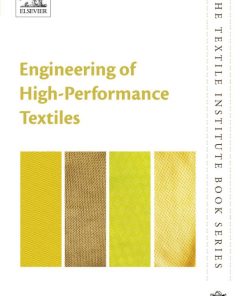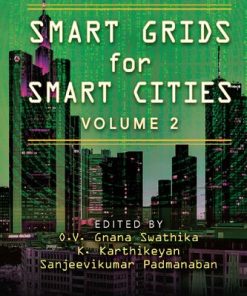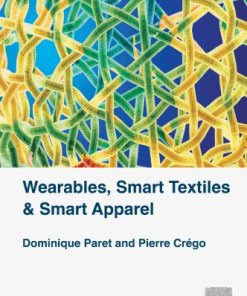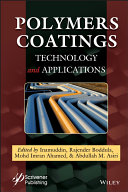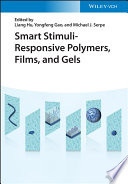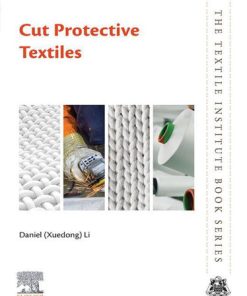(Ebook PDF) Active Coatings for Smart Textiles 1st Edition Hu, Jinlian 0081002653 9780081002636 9780081002650 full chapters
$50.00 Original price was: $50.00.$25.00Current price is: $25.00.
Active Coatings for Smart Textiles 1st Edition Hu, Jinlian – Ebook PDF Instant Download/DeliveryISBN: 0081002653, 9780081002636, 9780081002650
Full dowload Active Coatings for Smart Textiles 1st Edition after payment.

Product details:
ISBN-10 : 0081002653
ISBN-13 : 9780081002636, 9780081002650
Author: Hu, Jinlian
Active Coatings for Smart Textiles presents the latest information on active materials and their application to textiles in the form of coatings and finishes for the purpose of improving performance and creating active functional effects. This important book provides detailed coverage of smart coating types, processes, and applications.
After an introduction to the topic, Part One introduces various types of smart and active coatings, including memory polymer coatings, durable and self-cleaning coatings, and breathable coatings. Technologies and related processes for the application of coatings to textiles is the focus of Part Two, with chapters devoted to microencapsulation technology, plasma surface treatments, and nanotechnology-based treatments.
Active Coatings for Smart Textiles 1st Table of contents:
1. Introduction to active coatings for smart textiles
1.1. Introduction
1.2. Functions and applications of active coating
1.3. Development of smart materials for active coating
1.4. Development of processing technologies for active coating
1.5. Outline of the book
Part One. Types of active coatings
2. Memory polymer coatings for smart textiles
2.1. Introduction
2.2. Memory polymers
2.3. Functions of memory coating textiles
2.4. Conclusions
3. Environmentally mild self-cleaning processes on textile surfaces under daylight irradiation: Critical issues
3.1. Introduction: self-cleaning of textiles by mild environmental sunlight-activated processes
3.2. Pretreatment by and functionalization of surfaces by radiofrequency plasma and ultraviolet-C (184nanomoles)
3.3. Coating by colloidal titanium dioxide of artificial fibers such as polyamide and polyester: evaluation of self-cleaning performance under low-intensity solar irradiation
3.4. Coating by colloidal titanium dioxide of natural fibers: evaluation of self-cleaning performance under low-intensity solar irradiation
3.5. Cotton self-cleaning by titanium dioxide clusters attached by chemical spacers under low-intensity solar irradiation
3.6. Self-cleaning cotton textiles titanium dioxide–modified by silicon dioxide–protective layers
3.7. Coatings by binary oxides and/or promoted or enhanced copper-binary oxides leading to faster stain discoloration under low-intensity solar irradiation: reaction mechanism and surface characterization
3.8. Trend of work in this area: future directions
4. Smart durable and self-healing textile coatings
4.1. Introduction
4.2. Types and classifications of smart coatings for improving textile durability
4.3. Properties of textiles with durability-enhancing coatings
4.4. Applications of smart durable and self-healing textiles
4.5. Future trends
4.6. Conclusions
Sources of further information
5. Smart breathable coatings for textiles
5.1. Introduction
5.2. Working principles of smart breathable coatings
5.3. Materials for breathable coating
5.4. Methods of generating hydrophilic and microporous coatings
5.5. Testing and evaluation of different breathable coated fabrics
5.6. Applications
5.7. Conclusions and future trends
6. Conductive polymer coatings
6.1. Introduction
6.2. Conductive polymers for textile coating
6.3. Properties and applications of conducting polymers
6.4. Conclusion
7. Natural photonic materials for textile coatings
7.1. Introduction
7.2. Types and classifications of natural photonic materials
7.3. Photonic structures brought to textile coating
7.4. Structural-colored sensors by external stimuli
7.5. Summary and outlook
Part Two. Smart coating processes and technologies
8. Coating processes and techniques for smart textiles
8.1. Introduction
8.2. Substrate and coating interactions
8.3. Overview of coating
8.4. Traditional processes for textile coating
8.5. Coating for smart textiles
8.6. Future trends
9. Microencapsulation technology for smart textile coatings
9.1. Introduction
9.2. Benefits of microencapsulation for textiles
9.3. Microencapsulation technologies
9.4. Application procedures of microcapsules on textile substrate
9.5. Smart end uses of textile substrates containing microcapsules
9.6. Conclusions
10. Plasma surface treatments for smart textiles
10.1. Introduction
10.2. Principles of plasma creation
10.3. Plasma–substrate interactions
10.4. Applications of plasma surface treatments in smart textiles
10.5. Future trends
10.6. Conclusion
Sources of further information
11. Nanotechnology-based coating techniques for smart textiles
11.1. Introduction
11.2. Types and classifications of nanotechnology-based coating techniques
11.3. Nanofibre coating via electrospinning
11.4. Future trends
11.5. Conclusion
12. Biomimetic nanocoatings for structural coloration of textiles
12.1. Introduction
12.2. Characterization of biomimetic structural coloration
12.3. Structural colors of thin-film interference on textiles with electrostatic self-assembly
12.4. Structural colors of photonic crystals on textiles
12.5. Conclusions and future trends
13. Functional modification of fiber surface via sol–gel technology
13.1. Introduction
13.2. Hydrophobic and oleophobic modifications
13.3. Anti-ultraviolet property using titanium dioxide hybrid sol
13.4. Antibacterial finishing using cationic or titanium dioxide hybrid sol
13.5. Color fixation using smart silane coupling agent hybrid sol
13.6. Conclusion
Part Three. Applications of smart textiles with responsive coatings
14. Smart coatings for comfort in clothing
14.1. Introduction
14.2. Principles of comfort in textiles and clothing
14.3. Technologies for smart textile coatings
14.4. Functions of smart textile/apparel coatings
14.5. Future trends
14.6. Conclusion
Sources of further information
15. Smart coatings for sportswear
15.1. Introduction
15.2. Smart coating and functional requirements of sportswear
15.3. Smart coatings to enhance comfort in sportswear
15.4. Smart coating to provide protection
15.5. Smart coating for performance enhancement
15.6. Smart textiles for health and motion monitoring in sportswear
15.7. Conclusions
16. Smart coatings for protective clothing
16.1. Introduction
16.2. Smart coating for body armor application
16.3. Smart coating for hazardous material protective clothing
16.4. Smart coating for health care protective clothing
16.5. Smart coating for firefighter protective clothing
16.6. Future trends
17. Smart medical textiles based on cyclodextrins for curative or preventive patient care
17.1. Introduction
17.2. Cyclodextrin production, binding properties, and applications
17.3. Cyclodextrins grafted on textiles for medical purposes
17.4. Conclusion and perspectives
18. Smart coatings for textiles in architecture
18.1. Introduction
18.2. Current trends in advanced architecture and smart textiles for architectural applications
18.3. Current components and types of smart-coated textiles for architectural applications
18.4. Future trends in advanced architecture and smart textiles for architectural applications
18.5. Applications for interior, exterior use and for actuators
People also search for Active Coatings for Smart Textiles 1st:
smart textiles examples
smart fabrics examples
what are smart textiles
active textile tailoring
active smart textiles
You may also like…
Technique - Energy
Smart Grids for Smart Cities Volume 2 1st Edition O. V. Gnana Swathika
Engineering - Industrial Engineering & Materials Science
Wearables : Smart Textiles and Smart Clothes 1st Edition Dominique Paret
Uncategorized
(Ebook PDF) Smart Stimuli Responsive Polymers 1st edition by Liang Hu 9783527832385 full chapters
Engineering
Uncategorized




